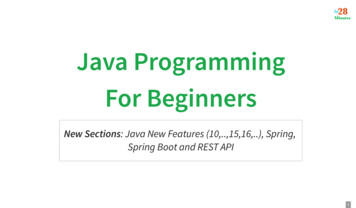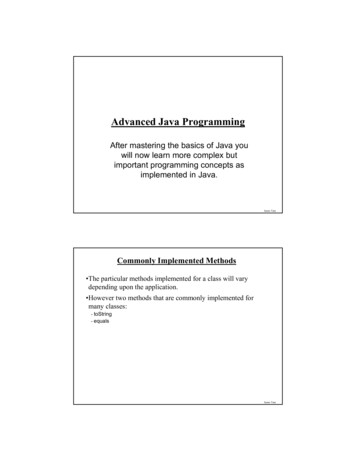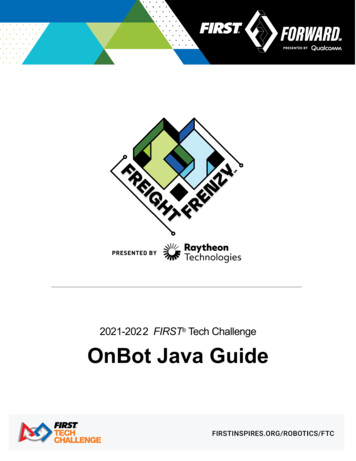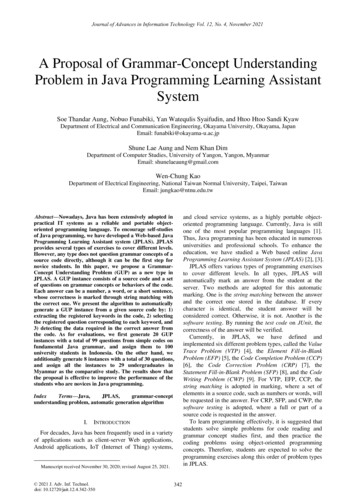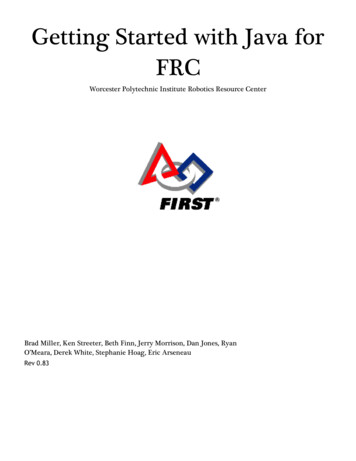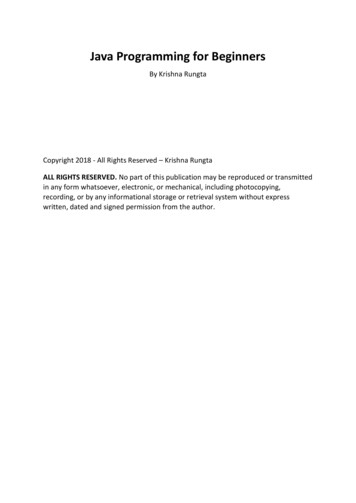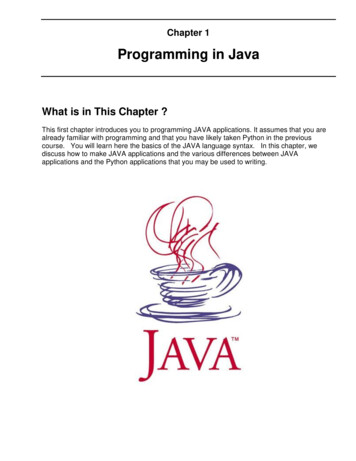
Transcription
Chapter 1Programming in JavaWhat is in This Chapter ?This first chapter introduces you to programming JAVA applications. It assumes that you arealready familiar with programming and that you have likely taken Python in the previouscourse. You will learn here the basics of the JAVA language syntax. In this chapter, wediscuss how to make JAVA applications and the various differences between JAVAapplications and the Python applications that you may be used to writing.
COMP1406 - Chapter 1 - Programming in JAVAWinter 20181.1 Object-Oriented Programming and JAVAObject-oriented programming (OOP) is a way of programming in which your code is organizedinto objects that interact with one another to form an application. When doing OOP, theprogrammer (i.e., you) spends much time defining (i.e., writing code for) various objects byspecifying the attributes (or data) that make up the object as well as small/simple functionalbehaviors that the object will need to respond to (e.g., deposit, withdraw, compute interest, getage, save data etc.)There is nothing magical about OOP. Programmers have been coding for years in traditionaltop/down structured programming languages. So what is so great about OO-Programming ?Well, OOP uses 3 main powerful concepts:Inheritance promotes code sharing and re-usabilityintuitive hierarchical code organizationEncapsulation provides notion of security for objectsreduces maintenance headachesmore robust codePolymorphism simplifies code understandingstandardizes method namingWe will discuss these concepts later in the course once we are familiar with JAVA.Through these powerful concepts, object-oriented code is typically: easier to understand (relates to real world objects)better organized and hence easier to work withsimpler and smaller in sizemore modular (made up of plug-n’-play re-usable pieces)better qualityThis leads to: high productivity and a shorter delivery cycleless manpower requiredreduced costs for maintenancemore reliable and robust softwarepluggable systems (updated UI’s, less legacy code)-2-
COMP1406 - Chapter 1 - Programming in JAVAWinter 2018Why Use JAVA ?JAVA has been a very popular object-oriented programming language for many years (and isstill). Many jobs require knowledge of JAVA, including co-op jobs here at Carleton.Top 10 Most Popular Languages(Tiobe Index Jan 2018)14.2%3.5%3.8%11.0%4.7%5.6%JavaCC PythonC#JavaScriptRPHPPerlRubyJAVA has become a basis for new technologies such as: Enterprise Java Beans (EJB’s),Servlets and Java Server Pages (JSPs), etc. In addition, many packages have been addedwhich extend the language to provide special features: Java Media Framework (for video streaming, webcams, MP3 files, etc)Java 3D (for 3D graphics)Java Advanced Imaging (for image manipulation)Java Speech (for dictation systems and speech synthesis)Java FX (for graphics, web apps, charts/forms, etc.)J2ME (for mobile devices such as cell phones)Java Embedded (for embedding java into hardware to create smart devices)JAVA is continually changing/growing. Each new release fixes bugs and adds features. Newtechnologies are continually being incorporated into JAVA. Many new packages are available.Just take a look at the www.oracle.com/technetwork/java/index.html website for the latestupdates.-3-
COMP1406 - Chapter 1 - Programming in JAVAWinter 2018There are many other reasons to use JAVA: architecture independenceo ideal for internet applicationso code written once, runs anywhereo reduces cost distributed and multi-threadedo useful for internet applicationso programs can communicate over network dynamico code loaded only when needed memory managedo automatic memory allocation / de-allocationo garbage collector releases memory for unused objectso simpler code & less debugging robusto strongly typedo automatic bounds checkingo no “pointers” (you will understand this in when you do C language programming)The JAVA programming language itself (i.e., the SDK (SoftwareDevelopment Kit) that you download from Oracle) actuallyconsists of many program pieces (or object class definitions)which are organized in groups called packages (i.e., similar tothe concept of libraries in other languages) which we can use inour own programs.When programming in JAVA, you will usually use: classes from the JAVA class libraries (used as tools)classes that you will create yourselfclasses that other people make available to youUsing the JAVA class libraries whenever possible is a good idea since: the classes are carefully written and are efficient.it would be silly to write code that is already available to you.We can actually create our own packages as well, but this will not be discussed in this course.-4-
COMP1406 - Chapter 1 - Programming in JAVAWinter 2018How do you get started in JAVA?When you download and install the latest JAVA SDK, you will not see any particularapplication that you can run which will bring up a window that you can start to make programsin. That is because the Oracle guys, only supply the JAVA SDK which is simply the compilerand virtual machine. JAVA programs are just text files, they can be written in any type of texteditor. Using a most rudimentary approach, you can actually open up windows NotePad andwrite your program . then compile it using the windows Command Prompt window. This canbe tedious and annoying since JAVA programs usually require you to write and compilemultiple files.A better approach is to use an additional piece of application software called an IntegratedDevelopment Environment (IDE). Such applications allow you to: write your code with colored/formatted textcompile and run your codebrowse java documentationcreate user interfaces visuallyand use other java technologiesThere are many IDE's that you can use to write JAVA code. Here are a few: IntelliJ (Windows, Mac OS X, Linux) - download from www.jetbrains.com/ideaEclipse (Windows, Mac OS X, Linux) - download from www.eclipse.orgJGrasp (Windows, Mac OS X, Linux) - download from www.jgrasp.comJCreator LE (Windows) - download from www.jcreator.comDr. Java (Windows, Mac OS X) - download from drjava.sourceforge.netYou may choose whatever you wish. HOWEVER . YOU MUST hand in exported IntelliJprojects for ALL of your assignments. So you should install and use IntelliJ for this course.-5-
COMP1406 - Chapter 1 - Programming in JAVAWinter 20181.2 Writing Your First JAVA ProgramThe process of writing and using a JAVA program is as follows:1. Writing: define your classes by writing what is called .java files (a.k.a. source code).2. Compiling: send these .java files to the JAVA compiler, which will produce .class files3. Running: send one of these .class files to the JAVA interpreter to run your program.The java compiler: prepares your program for running produces a .class file containing byte-codes (which is a program that is ready to run).If there were errors during compiling (i.e., called "compile-time" errors), you must then fixthese problems in your program and then try compiling it again.The java interpreter (a.k.a. Java Virtual Machine (JVM)): is required to run any JAVA program reads in .class files (containing byte codes) and translates them into a language thatthe computer can understand, possibly storing data values as the program executes.Just before running a program, JAVA uses a class loader to put the byte codes in thecomputer's memory for all the classes that will be used by the program. If the programproduces errors when run (i.e., called "run-time" errors), then you must make changes to theprogram and re-compile again.-6-
COMP1406 - Chapter 1 - Programming in JAVAWinter 2018Our First ProgramThe first step in using any new programming language is to understand how to write a simpleprogram. By convention, the most common program to begin with is always the "hello world"program which when run . should output the words "Hello World" to the computer screen.We will describe how to do this now. When compared to Python, you will notice that JAVArequires a little bit of overhead (i.e., extra code) in order to get a program to run.All of your programs will consist of one or more files called classes. In JAVA, each time youwant to make any program, you need to define a class.Here is the first program that we will write:public class HelloWorldProgram {public static void main(String[] args) {System.out.println("Hello World");}}Here are a few points of interest in regards to ALL of the programs that you will write in thiscourse: The program must be saved in a file with the same name as the class name (spelled thesame exactly with upper/lower case letters and with a .java file extension). In thiscase, the file must be called HelloWorldProgram.java. The first line beings with words public class and then is followed by the name of theprogram (which must match the file name, except not including the .java extension).The word public indicates that this will be a "publically visible" class definition that wecan run from anywhere. We will discuss this more later. The entire class is defined within the first opening brace { at the end of the first line andthe last closing brace } on the last line. The 2nd line (i.e., public static void main(String[] args) {) defines the starting placefor your program and will ALWAYS look exactly as shown. All JAVA programs startrunning by calling this main() procedure which takes a String array as an incomingparameter. This String array represents what are called "command-line-arguments"which allows you to start the program with various parameters. However, we will notuse these parameters in the course and so we will not discuss it further. The 2nd last line will be a closing brace }.So ignoring the necessary "template" lines, the actual program consists of only one line:System.out.println("Hello World"); which actually prints out the characters Hello World tothe screen. You may recall that this was a little simpler in Python since you simply did thisprint ("Hello World")So . to summarize, every java program that you will write will have the following basic format:-7-
COMP1406 - Chapter 1 - Programming in JAVAWinter 2018public class{public static void main(String[] args) {;;;}}Just remember that YOU get to pick the program name (e.g., MyProgram) which shouldALWAYS start with a capital letter. Also, your code MUST be stored in a file with the samename (e.g., MyProgram.java). Then, you can add as many lines of code as you would like inbetween the inner { } braces. You should ALWAYS line up ALL of your brackets using theTab key on the keyboard.When you run your program, any output from the program will appear in a System console,which is usually a pane in the IDE's window.Later in the course, we will create our own windows. For now, however, we will simply use theSystem console to display results. This will allow us to focus on understanding what is goingon "behind the scenes" of a windowed application. It is important that we first understand theprinciples of Object-Oriented Programming.1.3 Python vs. JavaPython code differs from JAVA code in regards to syntax. Provided here is a brief explanationof a few of the differences (and similarities) between the two languages:Commenting Code:PythonJAVA# single line comment// single line comment""" a multiline commentwhich spans morethan one line."""/* a multiline commentwhich spans morethan one line.*/Displaying Information to the System Console:Pythonprint("The avg is " avg)print("All Done")JavaSystem.out.println("The avg is " avg);System.out.println("All Done");-8-
COMP1406 - Chapter 1 - Programming in JAVAWinter 2018Math Functions:PythonJavamin(a, b)max(a, b)round(a)pow(a, (d)random.random()Math.min(a, b)Math.max(a, b)Math.round(a)Math.pow(a, dom()Variables:PythonJavahungry Truedays 15age 19years 3467seconds 1710239gender 'M'amount 21.3weight 165.23booleanintbyteshortlongcharfloatdoublehungry true;days 15;age 19;years 3467;seconds 1710239;gender 'M';amount 21.3f;weight 165.23;Constants:PythonJavado not make ourown by defaultfinal intfinal floatmath.piMath.PIDAYS 365;RATE 4.923f;Type Conversion:PythonJavadfigcdouble d 65.237898546;float f (float)d;int i (int)f;long g (long)i;char c (char)i; 65.237898546float(d)int(f)long(i)chr(i)-9-
COMP1406 - Chapter 1 - Programming in JAVAWinter 2018Arrays:PythonJavadays zeros(30, Int)weights zeros(100, Float)names [];rentals [];friends [];int[]double[]String[]Car[]Person[]ages [34, 12, 45]weights [4.5,2.6,1.5]names ["Bill", "Jen"]int[]ages {34, 12, 45};double[] weights {4.5,2.6,1.5};String[] names {"Bill", "Jen"};FOR loops:Pythondays new int[30];weights new double[100];names new String[3];rentals new Car[500];friends new Person[50];Javatotal 0int total 0;for i in range (1, n): for (int i 1; i n; i ) {total itotal i;}print(total)System.out.println(total);WHILE loops:Pythonspeed 0x 0while x width:speed speed 2x x speedJavaint speed int x 0;while (x speed x x }IF statements:Python0;width) {speed 2;speed;Javaif (grade 80) and (grade 100): if ((grade 80) && (grade f grade 50:print(grade)print("Passed!")else:print("Grade too low.")if (grade 50) sed!");}elseSystem.out.println("Grade too low.");- 10 -
COMP1406 - Chapter 1 - Programming in JAVAProcedures & Functions:PythonWinter 2018Javadef procName(x, c):// Write code herevoid procName(int x, char c)// Write code here}def funcName(h):result .// Write code herereturn resultdouble funcName(float h) {result .;// Write code herereturn result;}{As the course continues, you will notice other differences between Python and JAVA.However, the underlying programming concepts remain the same. As we do coding examplesthroughout the course, you will get to know the some of the other intricate details of basicJAVA syntax. Therefore, we will not discuss this any further at this point.1.4 Getting User InputIn addition to outputting information to the console window, JAVA has the capability to getinput from the user. Unfortunately, things are a little "messier/uglier" when getting input. Toget user input, we will make use of a class called Scanner which is available in the java.utilpackage (more on packages later). To do this, we will create a new Scanner object for inputfrom the System console. Here is the line of code that gets a line of text from the user:new Scanner(System.in).nextLine();This line of code will wait for the user (i.e., you) to enter some text characters using thekeyboard. It actually waits until you press the Enter key. Then, it returns to you thecharacters that you typed (not including the Enter key). You can then do something with thecharacters, such as print them out.Here is a simple program that asks users for their name and then says hello to them:import java.util.Scanner;// More on this laterpublic class GreetingProgram {public static void main(String[] args) {Scanner keyboard new Scanner(System.in);System.out.println("What is your name ?");System.out.println("Hello, " keyboard.nextLine());}}- 11 -
COMP1406 - Chapter 1 - Programming in JAVAWinter 2018Notice the output from this program if the letters Mark are entered by the user (Note that theblue text (i.e., 2nd line) was entered by the user and was not printed out by the program):What is your name ?MarkHello, MarkAs you can see, the Scanner portion of the code gets the input from the user and thencombines the entered characters by preceding it with the "Hello, " string before printing to theconsole on the second line.Interestingly, we can also read in integer numbers from the keyboard as well by using thenextInt() function instead of nextLine(). For example, consider this calculator programthat finds the average of three numbers entered by the user:import java.util.Scanner;// More on this laterpublic class CalculatorProgram {public static void main(String[] args) {int sum;Scanner keyboard new Scanner(System.in);System.out.println("Enter three numbers:");sum keyboard.nextInt() keyboard.nextInt() keyboard.nextInt();System.out.println("The average of these numbers is " (sum/3.0));}}Here is the output when the CalculatorProgram runs with the numbers 34, 89 and 17 entered:Enter three numbers:348917The average of these numbers is 46.666666666666664There is much more we can learn about the Scanner class. It allows for quite a bit offlexibility in reading input. In place of nextInt(), we could have used any one of the followingfunctions to obtain the specific kind of data value that we would like to get from the user:nextShort(), nextLong(), nextByte(), nextFloat(), nextDouble(),nextBoolean()We will discuss the various data values in Chapter 2 of these notes. But for now,Int/Short/Long/Byte return whole numbers, Float/Double return decimal numbers and Booleanreturns a true/false value.- 12 -
COMP1406 - Chapter 1 - Programming in JAVAWinter 2018Notice that there is no nextChar() function available. If you wanted to read a single characterfrom the keyboard (but don't forget that we still need to also press the Enter key), you coulduse the following: nextLine().charAt(0). We will look more into this later when we discussString functions. It is important to use the correct function to get user input. For example, ifwe were to enter 10, 20 into our program above, followed by some "junk" characters . anerror will occur telling us that there was a problem with the input as follows:java.util.InputMismatchException.at java.util.Scanner.nextInt(Unknown Source)at This is JAVA's way of telling us that something bad just happened. It is called an Exception.We will discuss more about this later. For now, assume that valid integers are entered.Example:Let us write a program that displays the following menu.Luigi's ML) M(MED) L(LRG)1. Cheese5.007.5010.002. Pepperoni5.758.6311.503. Combination6.509.7513.004. Vegetarian7.2510.8814.505. Meat Lovers8.0012.0016.00The program should then prompt the user for the type of pizza he/she wants to order (i.e., 1 to5) and then the size of pizza 'S', 'M' or 'L'. Then the program should display the cost of thepizza with 13% tax added.To begin, we need to define a class to represent the program and display the menu:public class LuigisPizzaProgram {public static void main(String[] args) {System.out.println("Luigi's ---------------------");System.out.println("S(SML) M(MED) L(LRG)");System.out.println("1. Cheese5.007.5010.00 ");System.out.println("2. Pepperoni5.758.6311.50 ");System.out.println("3. Combination6.509.7513.00 ");System.out.println("4. Vegetarian7.2510.8814.50 ");System.out.println("5. Meat Lovers8.0012.0016.00 ");}}We can then get the user input and store it into variables. We just need to add these lines(making sure to put import java.util.Scanner; at the top of the program):- 13 -
COMP1406 - Chapter 1 - Programming in JAVAWinter 2018Scanner keyboard new Scanner(System.in);System.out.println("What kind of pizza do you want (1-5) ?");int kind keyboard.nextInt();System.out.println("What size of pizza do you want (S, M, L) ?");char size keyboard.next().charAt(0);Annoying detail: Note that next() is used instead of nextLine(). That is because the previous call to nextInt() does not readthe leftover newline character. A call to nextLine() therefore, would read it and return an empty String which does not have acharacter in it. Using next() will read just one token/value not a whole sentence though. So it works in this case.Otherwise, we would have to call keyboard.nextLine() after keyboard.nextInt() to read that leftover newline character.Now that we have the kind and size, we can compute the total cost. Notice that the cost of asmall pizza increases by 0.75 as the kind of pizza increases. Also, you may notice that thecost of a medium is 1.5 x the cost of a small and the cost of a large is 2 x a small. So we cancompute the cost of any pizza based on its kind and size by using a single mathematicalformula. Can you figure out the formula ?A small pizza would cost:A medium pizza would cost:A large pizza would cost:smallCost 4.25 (kind x 0.75)mediumCost smallCost * 1.5largeCost smallCost * 2Can you write the code now ?float cost 4.25f (kind * 0.75f);if (size 'M')cost * 1.5f;else if (size 'L')cost * 2;And of course, we can then compute and display the cost before and after taxes. Here is thecompleted program:import java.util.Scanner;public class LuigisPizzaProgram {public static void main(String[] args) {System.out.println("Luigi's ---------------------");System.out.println("S(SML) M(MED) L(LRG)");System.out.println("1. Cheese5.007.5010.00 ");System.out.println("2. Pepperoni5.758.6311.50 ");System.out.println("3. Combination6.509.7513.00 ");System.out.println("4. Vegetarian7.2510.8814.50 ");System.out.println("5. Meat Lovers8.0012.0016.00 ");Scanner keyboard new Scanner(System.in);System.out.println("What kind of pizza do you want (1-5) ?");int kind keyboard.nextInt();System.out.println("What size of pizza do you want (S, M, L) ?");- 14 -
COMP1406 - Chapter 1 - Programming in JAVAWinter 2018char size keyboard.next().charAt(0);float cost 4.25f (kind * 0.75f);if (size 'M')cost * 1.5f;else if (size 'L')cost * 2;System.out.println("The cost of the pizza is: " cost);System.out.println("The price with tax is: " cost*1.13);}}The above program displays the price of the pizza quite poorly. For example, here is theoutput of we wanted a Large Cheese pizza:The cost of the pizza is: 5.0The price with tax is: 5.6499999999999995It would be nice to display money values with proper formatting (i.e., always with 2 decimalplaces). The next section will cover this.1.5 Formatting TextConsider the following similar program which asks the user for the price of a product, thendisplays the cost with taxes included, then asks for the payment amount and finally prints outthe change that would be returned:import java.util.Scanner;public class ChangeCalculatorProgram {public static void main(String[] args) {// Declare the variables that we will be usingdouble price, total, payment, change;// Get the price from the userSystem.out.println("Enter product price:");price new Scanner(System.in).nextFloat();// Compute and display the total with 13% taxtotal price * 1.13;System.out.println("Total cost: " total);// Ask for the payment amountSystem.out.println("Enter payment amount:");payment new Scanner(System.in).nextFloat();// Compute and display the resulting changechange payment - total;System.out.println("Change: " change);}}- 15 -
COMP1406 - Chapter 1 - Programming in JAVAWinter 2018Here is the output from running this program with a price of 35.99 and payment of 50:Enter product price:35.99Total cost: 40.66870172505378Enter payment amount:50Change: 9.33129827494622Notice all of the decimal places. This is not pretty. Even worse if you were to run theprogram and enter a price of 8.85 and payment of 10, the output would be as follows:Enter product price:8.85Total cost: 10.0005003888607Enter payment amount:10Change: -5.003888607006957E-4The E-4 indicates that the decimal place should be moved 4 units to the left so the resultingchange is actually - 0.0005003888607006957. While the above answers are correct, it wouldbe nice to display the numbers properly as numbers with 2 decimal places.JAVA’s String class has a nice function called format() which will allow us to format a String inalmost any way that we want to. Consider (from our code above) replacing the change outputline to:System.out.println("Change: " String.format("%,1.2f", change));The String.format() always returns a String object with a format that we get to specify. In ourexample, this String will represent the formatted change which is then printed out. Noticethat the function allows us to pass-in two parameters (i.e., two pieces of information separatedby a comma , character).The first parameter is itself a String object that specifies how we want to format the resultingString. The second parameter is the value that we want to format (usually a variable name).Pay careful attention to the brackets. Clearly, change is the variable we want to format.Notice the format string "%,1.2f". These characters have special meaning to JAVA. The %character indicates that there will be a parameter after the format String (i.e., the changevariable). The 1.2f indicates to JAVA that we want it to display the change as a floating pointnumber which takes at least 1 character when displayed (including the decimal) and exactly 2digits after the decimal. The , character indicates that we would like it to automatically displaycommas in the money amount when necessary (e.g., 1,500,320.28).We would apply this formatting to the total amount as well:- 16 -
COMP1406 - Chapter 1 - Programming in JAVAWinter 2018import java.util.Scanner;public class ChangeCalculatorProgram2 {public static void main(String[] args) {double price, total, payment, change;System.out.println("Enter product price:");price new Scanner(System.in).nextFloat();total price * 1.13;System.out.println("Total cost: " String.format("%,1.2f", total));System.out.println("Enter payment amount:");payment new Scanner(System.in).nextFloat();change payment - total;System.out.println("Change: " String.format("%,1.2f", change));}}Here is the resulting output for both test cases:Enter product price:35.99Total cost: 40.67Enter payment amount:50Change: 9.33Enter product price:8.85Total cost: 10.00Enter payment amount:10Change: -0.00It is a bit weird to see a value of -0.00, but that is a result of the calculation. Can you think of away to adjust the change calculation of payment - total so that it eliminates the - sign ? Try it.The String.format() can also be used to align text as well. For example, suppose that wewanted our program to display a receipt instead of just the change. How could we display areceipt in this format:Product 0.67Amount Tendered50.00 Change Due9.33If you notice, the largest line of text is the “Amount Tendered” line which requires 15characters. After that, the remaining spaces and money value take up 10 characters. Wecan therefore see that each line of the receipt takes up 25 characters. We can then use thefollowing format string to print out a line of , aString, aFloat));- 17 -
COMP1406 - Chapter 1 - Programming in JAVAWinter 2018Here, the %15s indicates that we want to display a string which we want to take up exactly 15characters. The %10.2f then indicates that we want to display a float value with 2 decimalplaces that takes up exactly 10 characters in total (including the decimal character). Noticethat we then pass in two parameters: which must be a String and a float value in that order(these would likely be some variables from our program). We can then adjust our program touse this new String format as follows import java.util.Scanner;public class ChangeCalculatorProgram3 {public static void main(String[] args) {doubleprice, tax, total, payment, change;System.out.println("Enter product price:");price new "Enter payment amount:");payment new Scanner(System.in).nextFloat();tax price * 0.13;total price tax;change payment - ","Product Price", 2f","Tax", "Subtotal", 2f","Amount Tendered", payment));System.out.println(" Change Due", change));}}The result is the correct formatting that we wanted. Realize though that in the above code, wecould have also left out the formatting for the 15 character strings by manually entering thenecessary spaces:System.out.println(String.format(" Product Price%10.2f", f", 2f", total));System.out.println(String.format("Amount Tendered%10.2f", payment));System.out.println(" ");System.out.println(String.format("Change Due%10.2f", change));However, the String.format function providesmuch more flexibility. For example, if we used%-15S instead of %15s, we would get a leftjustified result (due to the -) and capitalizedletters (due to the capital S) as follows:- 18 -PRODUCT 9.54AMOUNT TENDERED50.00 CHANGE DUE10.46
COMP1406 - Chapter 1 - Programming in JAVAWinter 2018There are many more format options that you can experiment with. Just make sure that yousupply the required number of parameters. That is, you need as many parameters as youhave % signs in your format string.For example, the following code will produce a MissingFormatArgumentException since one of thearguments (i.e., values) is missing (i.e., 4 % signs in the format string, but only 3 suppliedvalues:System.out.println(String.format(" %.2f %.2f %.2f %.2f", x, y, z));Also, you should be careful not to miss-match types, otherwise an error may occur (i.e.,IllegalFormatConversion
COMP1406 - Chapter 1 - Programming in JAVA Winter 2018 - 6 - 1.2 Writing Your First JAVA Program The process of writing and using a JAVA program is as follows: 1. Writing: define your classes by writing what is called .java files (a.k.a. source code). 2. Compiling: send these .java files to the JAVA compiler, which will produce .class files 3.



